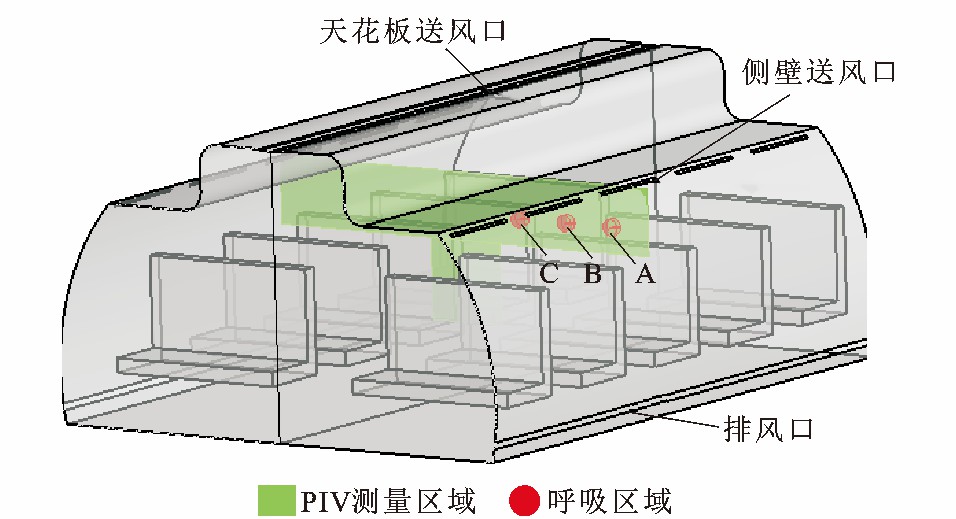Influence of air supply form on contaminat diffusion of bleed air in aircraft cabin
-
摘要: 采用联合仿真方法实现了飞机环境控制系统对座舱环境的调节, 建立了飞机环境控制系统到座舱环境闭环仿真模型, 研究了考虑再循环风时不同送风形式对引气污染物在座舱内乘客呼吸区域传播的影响; 以B737-200座舱模型为研究对象, 分析了引气污染发生时相同供气量与不同再循环风比例下, 天花板送风、侧壁送风、混合送风下污染物在呼吸区的分布情况。研究结果表明: 在污染物进入座舱阶段, 不同送风形式与再循环风比例下不同位置污染物浓度存在差异, 天花板送风形式下污染物浓度较大; 再循环风比例每增加20%, 混合送风、侧壁送风、天花板送风形式下污染物浓度分别降低约18.9%、20.6%、15.6%, 侧壁送风形式下污染物浓度降低最多; 在污染物排除阶段, 侧壁送风形式相较于混合送风和天花板送风形式下排污效率分别提升约42.6%和38.7%;采用混合送风或天花板送风形式时, 随着再循环风比例的增加, 排污效率显著提升, 再循环风比例每增加20%, 混合送风和天花板送风排污效率分别提高约10.7%和7.7%;侧壁送风形式下随着再循环风比例的增加, 排污效率无明显提升, 在较高再循环风比例仍可保持最好的排污效率, 能够实现污染物排除和节能的双重优化。可见, 飞机座舱引气污染事件发生时在不改变送风量情况下采用侧壁送风形式和高再循环风比例可以使污染物危害降到最低。Abstract: The co-simulation method was adopted to realize the adjustment of aircraft environmental control system to cabin environment. The closed-loop simulation model of aircraft environmental control system to cabin environment was established. The effects of different air supply forms on the propagation of airborne contaminant in the passenger breathing area were studied under considering recirculating air. Taking B737-200 cabin model as the research object, the distributions of contaminant in the breathing area under the ceiling, sidewall and mixed air supply modes were analyzed under the same air supply quantity and different proportions of recycled air when air contamination event occurs. Research result shows that in the state that the contaminant enter the cabin, the concentrations of contaminant in different air supply forms and the proportions of recycled air are different at different positions, and the concentration of contaminant in ceiling air supply form is higher. When the proportion of recycled air increases by 20%, the concentrations of contaminant in the forms of mixed air supply, sidewall air supply and ceiling air supply decrease by about 18.9%, 20.6% and 15.6%, respectively, and the contaminant concentration decreases most under the form of sidewall air supply. In the contaminant removal stage, compared with the mixed air supply and ceiling air supply, the contaminant removal efficiency of sidewall air supply increases by about 42.6% and 38.7%, respectively. When using the mixed air supply or ceiling air supply, the contaminant removal efficiency increases significantly with the increase of the proportion of recycled air. When the proportion of recycled air increases by 20%, the contaminant removal efficiencies of mixed air supply and ceiling air supply increase by about 10.7% and 7.7%, respectively. With the increase of the proportion of recycled air in the form of sidewall air supply, the contaminant removal efficiency is not significantly improved. At a higher proportion of recycled air, the best contaminant remove efficiency can still be maintained, which can realize the dual optimization of pollutant removal and energy saving. Therefore, the use of sidewall air supply and high recycled air ratio can minimize the harm of contaminant without changing the air supply volume.
-
表 1 边界条件参数
Table 1. Parameters of boundary conditions
送风方式 供气速度/ (m·s-1) 供气温度/℃ 天花板送风 3.0 25 侧壁送风 4.0 25 混合送风 天花板送风 2.5 25 侧壁送风 1.3 25 -
[1] HU Tao, LIU Meng, PANG Li-Ping, et al. Studies on new air purification and air quality control system of airliner cabin[J]. Procedia Engineering, 2011, 17: 343-353. doi: 10.1016/j.proeng.2011.10.039 [2] SHEHADI M, JONES B, HOSNI M. Bleed air contamination financial related costs on board commercial flights[J]. SAE International Journal of Aerospace, DOI: 10.4271/2015-01-9007. [3] KE Peng, SUN Chun-pin, ZHANG Shu-guang. Airworthiness requirements and means of compliance about the bleed air contamination[J]. Procedia Engineering, 2014, 80: 592-601. doi: 10.1016/j.proeng.2014.09.115 [4] 代炳荣. 飞机座舱动态空气净化系统研究[D]. 南京: 南京航空航天大学, 2013.DAI Bing-rong. Research on dynamic air purification system for aircraft cabin[D]. Nanjing: Nanjing University of Aeronautics and Astronautics, 2013. (in Chinese). [5] 何乐. 客机机舱环境热舒适研究[D]. 天津: 天津大学, 2010.HE Le. Simulation of thermal comfort in the aircraft cabin[D]. Tianjin: Tianjin University, 2010. (in Chinese). [6] 胡毅, 吕宝, 李毓峰. JSSG-2007军用飞机引气污染要求浅析[J]. 航空标准化与质量, 2016 (3): 48-51. https://www.cnki.com.cn/Article/CJFDTOTAL-HKBZ201603015.htmHU Yi, LYU Bao, LI Yu-feng. JSSG-2007 Brief analysis on air pollution of military aircraft[J]. Aeronautic Standardization and Quality, 2016 (3): 48-51. (in Chinese). https://www.cnki.com.cn/Article/CJFDTOTAL-HKBZ201603015.htm [7] LI Y, LEUNG G M, TANG J W, et al. Role of ventilation in airborne transmission of infectious agents in the built environment—a multidisciplinary systematic review[J]. Indoor Air, 2007, 17: 2-18. doi: 10.1111/j.1600-0668.2006.00445.x [8] ZHANG Zhao, CHEN Xi, MAZUMDAR S, et al. Experimental and numerical investigation of airflow and contaminant transport in an airliner cabin mockup[J]. Building and Environment, 2009, 44 (1): 85-94. doi: 10.1016/j.buildenv.2008.01.012 [9] HUANG Yan, SHEN Xiong, LI Jian-min, et al. A method to optimize sampling locations for measuring indoor air distributions[J]. Atmospheric Environment, 2015, 102: 355-365. doi: 10.1016/j.atmosenv.2014.12.017 [10] CAO Xiao-dong, LIU Jun-jie, PEI Jing-jing, et al. 2D-PIV measurement of aircraft cabin air distribution with a high spatial resolution[J]. Building and Environment, 2014, 82: 9-19. doi: 10.1016/j.buildenv.2014.07.027 [11] LI Fei, LIU Jun-jie, PEI Jing-jing, et al. Experimental study of gaseous and particulate contaminants distribution in an aircraft cabin[J]. Atmospheric Environment, 2014, 85: 223-233. doi: 10.1016/j.atmosenv.2013.11.049 [12] WU Chao-fan, AHMED N A. A novel mode of air supply for aircraft cabin ventilation[J]. Building and Environment, 2012, 56: 47-56. doi: 10.1016/j.buildenv.2012.02.025 [13] FIŠER J, JÍCHA M. Impact of air distribution system on quality of ventilation in small aircraft cabin[J]. Building and Environment, 2013, 69: 171-182. doi: 10.1016/j.buildenv.2013.08.007 [14] MAZUMDAR S, LONG Zhen-wei, CHEN Qing-yan. A coupled CFD and analytical model to simulate airborne contaminant transmission in cabins[J]. Indoor and Built Environment, 2014, 23 (7): 946-954. doi: 10.1177/1420326X13503957 [15] YOU Ruo-yu, CHEN Jun, SHI Zhu, et al. Experimental and numerical study of airflow distribution in an aircraft cabin mock-up with a gasper on[J]. Journal of Building Performance Simulation, 2016, 9 (5): 555-566. doi: 10.1080/19401493.2015.1126762 [16] ZHAO Ying-jie, DAI Bing-rong, YU Qi, et al. Numerical simulation study on air quality in aircraft cabins[J]. Journal of Environmental Sciences, 2017, 56: 52-61. doi: 10.1016/j.jes.2016.03.034 [17] MELIKOV A, IVANOVA T, STENFANOVA G. Seat headrest-incorporated personalized ventilation: thermal comfort and inhaled air quality[J]. Building and Environment, 2012, 47: 100-108. doi: 10.1016/j.buildenv.2011.07.013 [18] FANG Zhao-song, LIU Hong, LI Bai-zhan, et al. Experimental investigation of personal air supply nozzle use in aircraft cabins[J]. Applied Ergonomics, 2015, 47: 193-202. doi: 10.1016/j.apergo.2014.09.011 [19] 陈希远, 王振斌, 马博文, 等. 考虑污染物传播规律的飞机座舱送风方式研究[J]. 航空学报, 2018, 39 (7): 121994-1-10. https://www.cnki.com.cn/Article/CJFDTOTAL-HKXB201807007.htmCHEN Xi-yuan, WANG Zhen-bin, MA Bo-wen, et al. Study on air supply mode of aircraft cabin considering contaminant transmission laws[J]. Acta Aeronautica et Astronautica Sinica, 2018, 39 (7): 121994-1-10. (in Chinese). https://www.cnki.com.cn/Article/CJFDTOTAL-HKXB201807007.htm [20] LI Meng-xi, ZHAO Bin, TU Ji-yuan, et al. Study on the carbon dioxide lockup phenomenon in aircraft cabin by computational fluid dynamics[J]. Building Simulation, 2015, 8: 431-441. doi: 10.1007/s12273-015-0217-8 [21] YOU Ruo-yu, LIU Wei, CHEN Jun, et al. Predicting airflow distribution and contaminant transport in aircraft cabins with a simplified gasper model[J]. Journal of Building Performance Simulation, 2016, 9 (6): 699-708. doi: 10.1080/19401493.2016.1196730 [22] LI Meng-xi, YAN Yi-huan, ZHAO Bin, et al. Assessment of turbulence models and air supply opening models for CFD modelling of airflow and gaseous contaminant distributions in aircraft cabins[J]. Indoor and Built Environment, 2017, DOI: 10.1177/1420326X16688049. [23] 王丽丽, 李舜酩, 于国强, 等. 民机舱室结构建模及基于FEM-BEM的辐射噪声仿真分析[J]. 机械设计与制造工程, 2013, 42 (11): 10-13. https://www.cnki.com.cn/Article/CJFDTOTAL-JXZZ201311003.htmWANG Li-li, LI Shun-ming, YU Guo-qiang, et al. The modeling of civil aircraft cabin and numerical simulation of radiation noise based on FEM/BEM[J]. Machine Design and Manufacturing Engineering, 2013, 42 (11): 10-13. (in Chinese). https://www.cnki.com.cn/Article/CJFDTOTAL-JXZZ201311003.htm [24] YIN Hai-shen, SHEN Xiong, HUANG Yan, et al. Modeling dynamic responses of aircraft environmental control systems by coupling with cabin thermal environment simulations[J]. Building Simulation, 2016, 9 (4): 459-468. doi: 10.1007/s12273-016-0278-3 [25] 刘俊杰, 刘素梅, 孙贺江, 等. 大型客机座舱合理排数的数值模拟[J]. 天津大学学报(自然科学与工程技术版), 2013, 46 (1): 8-15. https://www.cnki.com.cn/Article/CJFDTOTAL-TJDX201301004.htmLIU Jun-jie, LIU Su-mei, SUN He-jiang, et al. Numerical simulation of the reasonable row number for commercial aircraft cabins[J]. Journal of Tianjin University (Science and Technology), 2013, 46 (1): 8-15. (in Chinese). https://www.cnki.com.cn/Article/CJFDTOTAL-TJDX201301004.htm [26] ZHANG Zhao, ZHANG Wei, ZHAI Zhi-qiang, et al. Evaluation of various turbulence models in predicting airflow and turbulence in enclosed environments by CFD: part2—comparison with experimental data from literature[J]. Science and Technology for the Built Environment, 2007, 13 (6): 871-886. [27] LIU Su-mei, XU Lu-yi, CHAO Jiang-yue, et al. Thermal environment around passengers in an aircraft cabin[J]. Science and Technology for the Built Environment, 2013, 19 (5): 627-634. [28] GAO N P, NIU J L. CFD study of the thermal environment around a human body: a review[J]. Indoor and Built Environment, 2005, 14 (1): 5-16. doi: 10.1177/1420326X05050132 [29] 刘俊杰, 朱学良, 曹晓东, 等. 客舱内自然对流运动对流场影响的实验研究[J]. 天津大学学报(自然科学与工程技术版), 2016, 49 (3): 221-230. https://www.cnki.com.cn/Article/CJFDTOTAL-TJDX201603002.htmLIU Jun-jie, ZHU Xue-liang, CAO Xiao-dong, et al. Experimental research on the influence of natural convection on the flow field in the cabin mockup[J]. Journal of Tianjin University (Science and Technology), 2016, 49 (3): 221-230. (in Chinese). https://www.cnki.com.cn/Article/CJFDTOTAL-TJDX201603002.htm [30] LEMOS R D L, VIEIRA R S, ISOLDI L A, et al. Numerical analysis of a turbulent flow with Coanda effect in hydrodynamics profiles[J]. FME Transactions, 2017, 45: 412-420. [31] 马仁民. 通风的有效性与室内空气品质[J]. 暖通空调, 2000, 30 (5): 20-23. https://www.cnki.com.cn/Article/CJFDTOTAL-NTKT200005009.htmMa Ren-min. Ventilation effectiveness and IAQ[J]. Heating Ventilating and Air Conditioning, 2000, 30 (5): 20-23. (in Chinese). https://www.cnki.com.cn/Article/CJFDTOTAL-NTKT200005009.htm -





 下载:
下载:



















